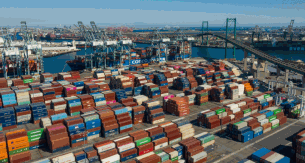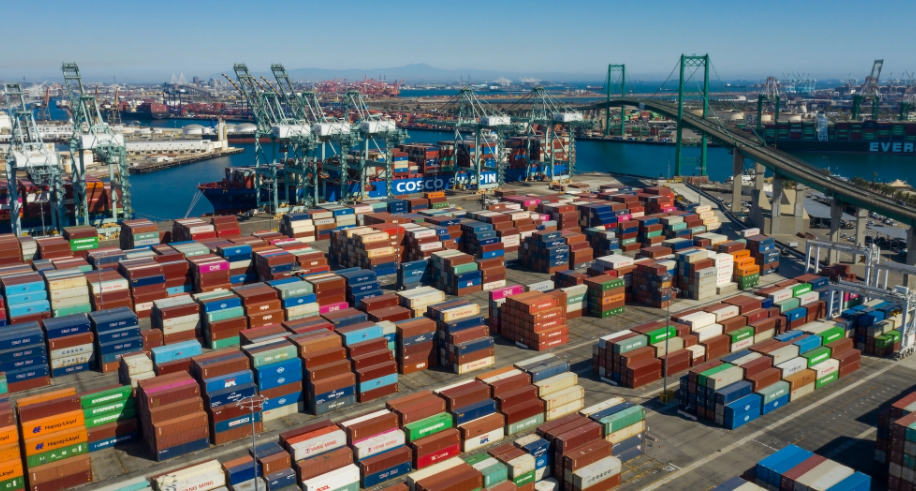其实,洛杉矶/长滩港并不一直是通往美国的主要集装箱门户港口,这个桂冠曾经属于纽约/新泽西港。近几十年来,集装箱化加上来自亚洲进口的不断增加以及横贯大陆的铁路使市场局势向美国西海岸转移,但是现在局势又回到了东海岸。
1805年,第一艘美国商船停靠在加利福尼亚的圣佩德罗湾。1850年,加州成为美国第31个州,港口活动蓬勃发展。20世纪初,洛杉矶人口激增,进一步促进了商业发展。1912年,在巴拿马运河开通前两年,主航道被疏浚。
20世纪60年代和70年代,随着航运业转向集装箱运输,东海岸仍保持着主导地位。根据美国运输统计局(BTS)的历史数据,1981年美国东海岸和墨西哥湾沿岸港口仍处理着该国66%的集装箱贸易。BTS的数据显示,直到1989年,美国西海岸才处于领先地位。
McCown报告整理了东海岸/西海岸各自的数据,涵盖了美国前10大港口。根据McCown的数据,到2000年,西海岸港口的进口份额已经上升到65%。洛杉矶/长滩港当年处理了490万TEU集装箱,是纽约/新泽西港的三倍多。
在世纪之交,洛杉矶/长滩港显然已经夺得桂冠,但竞争远未结束。


东海岸港口夺回市场份额
美国的海外进口激增,集装箱船的规模也在不断扩大。2000年至2015年间,洛杉矶港的进口量增长了57%。同期,纽约/新泽西港的集装箱进口量增长了113%;萨凡纳港增长了288%;诺福克港增长了90%;休斯顿港增长了148%。
2015年,西海岸在美国前十大港口中的进口份额已回落至57%。随后,扩建后的巴拿马运河开通,允许大型船舶从亚洲过境到东海岸,东西海岸之间的差距进一步缩小。截至去年,东海岸的进口份额达到49%。
根据McCown的说法,东海岸和墨西哥湾沿岸港口从1995年占总进口量的36.5%过渡到2015年(巴拿马运河扩建前的最后一年)的43.3%,相当于平均每年转变34个基点。
“随后从2015年的43.3%增加到2021年的48.8%,相当于平均每年转变92个基点,这表明,允许规模大三倍以上的集装箱船通过的巴拿马运河正在加速这一转变,并将继续下去。”
德意志银行运输分析师Amit Mehrotra在2020年接受American Shipper采访时坚称,对东海岸的拉动是一种长期趋势。他说:“请记住,60%的人口生活在密西西比州东部。归根结底,如果进入西海岸,将不得不通过铁路把大部分货物向东部运输,送到需求中心所在的地方。”
“巴拿马运河的扩建和东海岸港口项目允许挂靠更大的船舶,再加上东部的大多数人口,这将不成比例地有利于东海岸港口。”


疫情期间也带来了更多变化。2021年上半年,随着托运人争相运进更多货物,洛杉矶/长滩港受到青睐。然后,南加州港口出现了严重拥堵。更多的货物转移到巴拿马运河航线。而对西海岸劳资谈判结果的担忧给东海岸带来了另一个优势。
在截至4月的三个月内,东海岸和墨西哥湾沿岸港口实际上以50.2%的进口份额略微领先。即便如此,洛杉矶/长滩港仍是美国迄今为止最大的门户港口,其处理的集装箱进口量是纽约/新泽西港的两倍。
展望未来,McCown认为选择东海岸对许多进口商来说更有意义。
“当我1980年开始在McLean Industries工作时,美国船公司的跨大西洋贸易航线几乎与跨太平洋贸易航线运输量一样大。”他告诉American Shipper。
“帮助西海岸的另一个重要因素(除了亚洲进口量的增加外)是双层火车服务的增长,这使得去东部人口中心可以比全水路服务(通过巴拿马运河)更快到达。”
“但从单纯的成本、排放和拥堵的角度来看,现在有太多的集装箱从西海岸入境。”McCown认为,“如果只解决这三个因素而忽略运输时间,那么只有约25%的进口集装箱应该通过西海岸入境。”
来源:搜航网